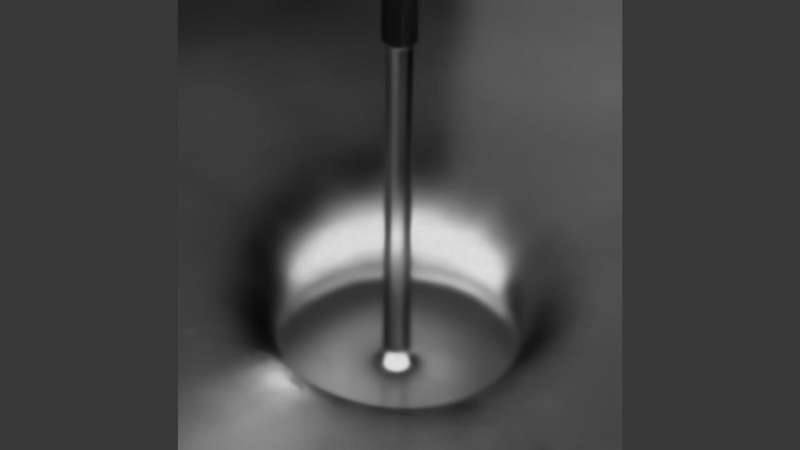November 24, 2023 feature
This article has been reviewed according to Science X's editorial process and policies. Editors have highlighted the following attributes while ensuring the content's credibility:
fact-checked
peer-reviewed publication
trusted source
proofread
Breaking the stillness: Scientists observe and explain the oscillations of circular hydraulic jumps

In a new study published in Physical Review Letters, scientists explore how small water jets can create stable periodic oscillations on a solid disk, uncovering a connection between these movements and the waves they generate and providing insights into the dynamic interplay of fluid behavior.
A hydraulic jump is a phenomenon that occurs when a fast-flowing liquid abruptly encounters a slower-flowing or stagnant region. This sudden transition results in a change in the flow's characteristics, causing the formation of a visible jump or surge in the liquid's height.
In this process, the kinetic energy of the fast-flowing liquid is converted into potential energy, leading to changes in velocity and flow depth. This phenomenon is commonly observed in various settings, such as when a liquid jet impacts a surface, for example in rivers or downstream from dams.
Now, researchers from France have investigated a scenario where a circular hydraulic jump undergoes stable periodic oscillations on a solid disk.
Explaining the team's motivation behind the study, lead author Aurélien Goerlinger told Phys.org, "The hydraulic jump is a ubiquitous phenomenon that seems simple. However, it is counterintuitive as nature prefers smooth transitions over abrupt ones.
"Consequently, the hydraulic jump is difficult to model, despite being studied since the time of Da Vinci. Since many fundamental aspects remain to be understood or even discovered, the hydraulic jump remains an active field of study for our team."
Circular hydraulic jumps and water jets
The experimental setup in the study involved generating circular hydraulic jumps on a solid disk using a submillimeter water jet.
The researchers initiated a submillimeter water jet, with an inner diameter of 0.84 mm, directed onto a Plexiglas disk with a 90-degree-angle-edged surface positioned 1 cm below the point of impact.
This process resulted in the formation of a circular pattern of discontinuity where the liquid established a thin film around the impact point. The thin film suddenly thickened at a certain radial distance, giving rise to the characteristic circular shape of the hydraulic jump.
To help visualize this phenomenon, Goerlinger provided an analogy, stating, "When one opens the tap in their kitchen and looks at the bottom of the sink near the impact of the liquid jet, we can observe a roughly circular liquid wall separating two distinct areas.
"The inner area, near the jet, is shallow but the flow is fast, whereas the outer area is much deeper but the flow is also much slower. This liquid wall is called a circular hydraulic jump."
The researchers then varied experimental parameters, including the flow rate (2 to 3 mL/s) and the disk radius (1 to 6 cm). They observed different behaviors based on these parameters, such as stationary jumps, transient states with oscillations, bistable states with periodic oscillations, and systematic stable periodic oscillations.
The analysis revealed that the period of oscillation did not depend on the flow rate but showed a linear dependence on the disk radius.
Interestingly, for disk radii more than 5 cm, the data points exhibited two distinct linear trends with different slopes, indicating two distinct oscillation modes, which the researchers refer to as fundamental and harmonic modes.
Interaction between hydraulic jumps and gravity waves
The researchers developed a theoretical model to explain the observed stable spontaneous oscillations, suggesting that it stems from the interaction between the hydraulic jump and surface gravity waves formed within the disk cavity.
Surface gravity waves propagate along the surface of the liquid and get reflected at the edge of the circular hydraulic jump. This reflection contributes to the establishment and maintenance of the oscillations. Furthermore, these waves are said to be amplified when they align with one of the disk cavity modes.
Remarkably, the researchers' theoretical model not only explains the observed oscillations but also provides predictive capabilities. It anticipated the coupling of distant jets to induce oscillations in opposing phases, a phenomenon confirmed through experimental observation.
In practical terms, this means that the rhythmic ebb and flow of one water jet could influence the oscillations of the other, creating a synchronized dance where the peaks and troughs of one jet correspond inversely to those of the other.
Goerlinger highlighted the significance of their work: "Despite extensive research on this phenomenon, the circular hydraulic jump has been found to remain stationary in most cases. However, our is the first to report stable spontaneous oscillations of the hydraulic jump occurring while the impacting jet is steady. Additionally, we managed to build a model that predicts the behavior of these oscillations."
Potential applications and future work
By successfully modeling the stable periodic oscillations, the theoretical framework contributes to a deeper understanding of the complex dynamics involved in hydraulic jumps.
This understanding can have implications for various fields, including fluid dynamics and related engineering applications.
"Hydraulic jumps are of great interest in areas where cooling and cleaning surfaces are needed. It may also find its interest in high-speed or 3D printers," explained Goerlinger.
Goerlinger believes they are only scratching the surface with this research and explained that they plan to continue research in this area.
"We have only partially explored the rich physics of this new phenomenon. Effects of many experimental parameters remain to be investigated, such as fluid properties or substrate geometry.
"Moreover, our work paves the way for the study of the interactions between multiple oscillating jumps and the interactions between hydraulic jumps and waves in general," he concluded.
More information: Aurélien Goerlinger et al, Oscillations and Cavity Modes in the Circular Hydraulic Jump, Physical Review Letters (2023). DOI: 10.1103/PhysRevLett.131.194001
Journal information: Physical Review Letters
© 2023 Science X Network





















